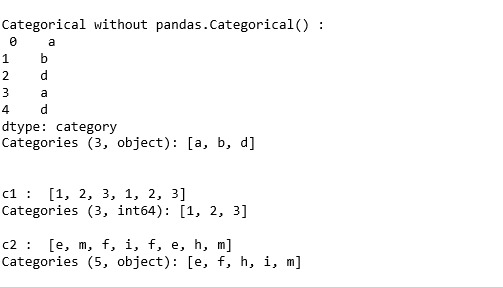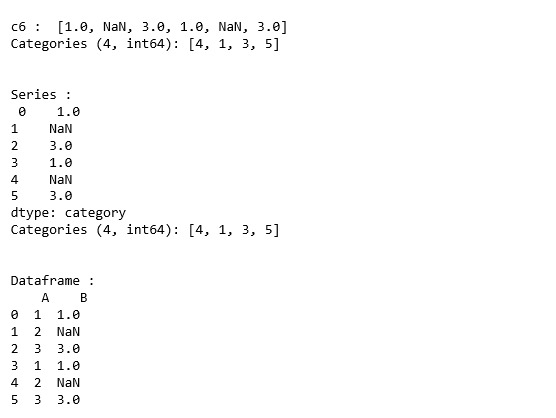pandas.Categorical(val,category = None,ordered = None,dtype = None):它代表一個分類變量。分類是一種 Pandas 數據類型,它對應於統計數據中的分類變量。這樣的變量具有固定且有限數量的可能值。例如-等級,性別,血型類型等。
同樣,在分類變量的情況下,邏輯順序與分類數據不同,例如“one”,“two”,“three”。但是這些變量的排序使用邏輯順序。
Parameters-val :[list-like] The values of categorical. categories:[index like] Unique categorisation of the categories. ordered :[boolean] If false, then the categorical is treated as unordered. dtype :[CategoricalDtype] an instance.Error-ValueError: If the categories do not validate. TypeError : If an explicit ordered = True but categorical can't be sorted. Return- Categorical varibale
代碼:
# Python code explaining
# numpy.pandas.Categorical()
# importing libraries
import numpy as np
import pandas as pd
# Categorical using dtype
c = pd.Series(["a", "b", "d", "a", "d"], dtype ="category")
print ("\nCategorical without pandas.Categorical():\n", c)
c1 = pd.Categorical([1, 2, 3, 1, 2, 3])
print ("\n\nc1:", c1)
c2 = pd.Categorical(['e', 'm', 'f', 'i',
'f', 'e', 'h', 'm' ])
print ("\nc2:", c2)輸出:

# Ordered = True
c3 = pd.Categorical(['e', 'm', 'f', 'i',
'f', 'e', 'h', 'm' ], ordered = True)
print ("\nc3:", c3)輸出:

# Mixed categories
c4 = pd.Categorical(['a', 2, 3, 1, 2, 3])
print ("\nc4:", c4)
c5 = pd.Categorical(['a', 2, 3, 1, 2, 3], ordered = True)
print ("\nc5:", c5)輸出:

# using categories attribute
c6 = pd.Categorical([1, 2, 3, 1, 2, 3], categories = [4, 1, 3, 5])
print ("\nc6:", c6)
print("\n\nSeries:\n", pd.Series(c6))
df = pd.DataFrame({"A":[1, 2, 3, 1, 2, 3]})
df["B"] = c6
print ("\n\nDataframe:\n", df)輸出:

相關用法
注:本文由純淨天空篩選整理自Mohit Gupta_OMG 大神的英文原創作品 Python | Pandas.Categorical()。非經特殊聲明,原始代碼版權歸原作者所有,本譯文未經允許或授權,請勿轉載或複製。
